Collective Driving to Mitigate Climate Change: Collective-Adaptive Cruise Control
Abstract
1. Introduction
- Concept: We have introduced a novel concept in energy-optimal algorithms to prevent the negative impact of these algorithms on traffic flow. Our concept not only solved the issue but also discovered a substantial emission saving opportunity (i.e., up to USD 35 million per day in the U.S.).
- Method: We have formulated a multi-objective optimization (i.e., no need to sum up distinct objective functions (e.g., fuel and safety)) and used a metaheuristic optimization algorithm (i.e., NSGA-II). NSGA-II solved the optimization in approximately 0.4 s, overcoming the long run-time issue reported in the previous studies [21,22].
- Scope: To the best of our knowledge, this is the first study that investigated the adoptability and socio-economic impacts of its energy-optimal algorithm. This study went beyond developing a theoretical algorithm and used game theory and stakeholder analysis to determine the pros and cons of adopting this technology for the stakeholders. This analysis provides valuable recommendations for policymakers, automakers, and environmental advocates.
2. Definitions
3. Literature Review
| Author | Type | Method | Result |
|---|---|---|---|
| Lin et al., 2016 [27] | Ecological-CC for PHEV | They optimized electric and gas consumption, considering MPC for the leading vehicle and topography of the roadway. They used an engine deterministic model to estimate fuel consumption. | It improved fuel efficiency by 3% in comparison with a classic cruising control system. |
| Saerens et al., 2013 [29] | Ecological-CC | They optimized fuel consumption and travel time. They used an engine deterministic model to estimate fuel consumption. | They reported a 5% fuel saving in comparison with a classic cruising control system. |
| Vajedi and Azad, 2016 [10] | Ecological-ACC for PHEV | They aimed to optimize energy cost (i.e., gas and electric) and a soft safety constraint. The model considers road topography and MPC for the leading vehicle. An engine deterministic model was used to estimated fuel consumption. | Traffic simulations showed that the model reduces total energy cost by up to 19%. |
| Ahn et al., 2013 [32] | Ecological-ACC | It used a speed range selected by the driver and topographic data to minimize fuel consumption. They used an engine deterministic model to estimate fuel consumption. | The model could save up to 10% in fuel, depending on the speed range selected by the driver. |
| Tajeddin et al., 2019 [31] | Ecological-ACC with lane changing and V2V | The model received information of surrounding vehicles through V2V communication and performed lane-changing if needed. It optimized fuel consumption, variation from defined speeds, and a soft safety constraint. | They found up to 27% fuel-saving possibilities depending on traffic flow conditions. |
| Wang et al., 2014 [28] | Ecological-ACC | They developed an energy-efficient model improving CO2, comfort, safety, and driving at the desired speed. They also developed a travel-efficient model increasing driving in desire speed and comfort. | The energy-efficient model reduced CO2 by 3% and 9% at the free-flow and congested conditions, respectively, compared to the travel-efficient model. The energy-efficient model achieved a 5% higher road capacity than the travel-efficient model. |
| He et al., 2020 [51] | ACC | They performed a road test with 5 ACC-equipped vehicles when the ACC was on and off. | ACC showed a quick response to fluctuation in speed and caused traffic instability. Fuel consumption had increased by 12% for the immediate followers and by 14% for the platoon. |
| Kamal et al., 2015 [45] | Energy-optimal CAV with lane-changing | The model optimized speed variation from fuel optimum speed with acceleration, safety, and lane-change penalties. They used MPC and rolling horizon for the optimization. | The model improved fuel efficiency by 7%, but it dropped the mean velocity by 7%. |
| Park et al., 2011 [43] | Energy-optimal ACC | The model received a cruising speed from the driver and optimized fuel and variation from the cruising speed with a gear change penalty. MPC was used to predict traffic conditions. | It showed fuel savings between 30% and 60% in different scenarios. |
| Bertoni et al., 2017 [52] | Energy-optimal CACC for EVs | It minimized energy consumption for EVs at a platoon. The difference between this model and the others was that each EV shared its planned trajectory for its following EV. So, the following EV optimized its trajectory accordingly. | They found a 15% reduction in fuel consumption in highway travel. |
| Weißmann et al., 2018, 2017 [32,33] | Energy-optimal Ecological-ACC | They developed an offline–online fuel optimization ACC algorithm. First, it estimated fuel-efficient trajectory for the whole route based on topographic data. Then, an online optimization minimized variation from the optimum trajectory. They used three planning horizons (4 s, 10 s, and 20 s). They tried two models to predict the leading vehicle’s trajectory (i.e., constant speed and full knowledge). | Their simulation scenario (single vehicle following another vehicle) found average energy savings of 7.5% for full-knowledge and 7.2% for constant speed. They also found that a longer-rolling horizon results in slightly more fuel savings. |
| Yang et al., 2021 [53] | Energy-optimal ACC | They assumed that energy consumption has a direct relation with acceleration. So, they proposed an energy-optimal ACC to minimize acceleration, improve ride comfort (i.e., minimize jark value), and follow the leading car with a minimal gap variation. They estimated the proceeding vehicle’s location by a longitudinal car-following model. They applied active disturbance rejection control (ADRC) to smoothen the speed trajectory for ACC. | They performed a real road test by an equipped vehicle. The algorithm reduced average acceleration by 11% from conventional ACC. Adding ADRC reduced average acceleration by up to 84%. They did not report a change in fuel consumption. |
| Jia et al., 2020 [22] | Energy-optimal ACC | They compared the performance of three different MPC approaches, including liner MPC, hybrid model predictive control (HMPC), and receding horizon dynamic programming (RHDP). Their algorithm aimed to minimize fuel consumption with soft constraints on safety and comfort. | They conducted a traffic simulation and found that RHDP has the highest energy saving capability (12%) and liner MPC (7%) has the lowest saving capability. However, liner MPC had a significantly better computation time (12 ms) than RHDP (2850 ms). |
| Han et al., 2020 [49] | Energy-optimal CACC with V2I communication | They developed an energy-optimal CACC for a platoon of vehicles with V2V and V2I communications. The leading vehicle in the platoon performs fuel optimization, and the other vehicles follow it. The leading vehicle also receives traffic information through V2I communication to pass traffic lights on time. This vehicle finds a right gap between the vehicles in the platoon to pass traffic lights and does not break the platoon. | The algorithm could reduce fuel consumption by 10% if an MPC model selects the gap. |
| Jia et al., 2020 [46] | Energy-optimal ACC | They proposed a new approach to predict the preceding vehicle’s location by a deep learning model (i.e., a recurrent neural network with long short-term memory). The model used various driving data (e.g., speed trajectories, traffic light statuses, and road conditions). Since there was not sufficient data to train a deep learning model, they used VISSIM simulation to generate enough data for the training. | This study only presented a new concept, and there was not any energy-saving result. |
| Hattori et al., 2021 [21] | Energy-optimal Ecological-ACC | They focused on reducing the computation time of energy-optimal ACC algorithms. They used quadrant dynamic programming (QDP) and generated an offline table to estimate optimal speed for a given traffic condition. This approach helped to make the algorithm running in real-time. | They performed a traffic simulation for electric vehicles. They reported 16% energy saving. |
| Jia et al., 2021 [47] | Energy-optimal Ecological-ACC | This study proposed a data-driven energy-optimal ecological-ACC for heavy-duty vehicles (HDVs). The model combined weather data, historical traffic data, 3D road maps, and local traffic data to predict traffic conditions and optimize fuel consumption. They used a convolutional neural network (CNN). | They found that the proposed algorithm could reduce fuel consumption by 11% compared to an average traffic speed policy. In congested traffic, there was less fuel-saving opportunity. |
| M. Mamouei et al., 2018 [16] | Energy-optimal ACC | They optimized IDM parameters to generate an ACC model that minimizes fuel consumption. They developed two ACC models: (1) minimize user-oriented fuel consumption and (2) minimize system-oriented fuel consumption (i.e., the whole network). They used a simulation-based optimization that tries different IDM parameter sets to find a set that minimizes fuel consumption. | The user-oriented ACC reduced fuel consumption by 12% for the equipped vehicle, but it increases network-level fuel consumption by 34%. Road capacity also dropped by 27%. System-oriented ACC increased equipped vehicle’s fuel consumption by 12%, but it increased road capacity by 39% and the network fuel consumption by 18%. These benefits were more significant in long simulations and high traffic flow. |
4. Method
4.1. Modeling Predictive Control
4.2. Optimization Function
4.2.1. Optimizing Direct Fuel Consumption and Emissions
4.2.2. Optimizing Indirect Fuel Consumption and Emissions
- (1)
- Car-following condition;
- (2)
- Blocking traffic flow;
- (3)
- Free-flow condition.
4.2.3. Multi-Objective Optimization
4.3. Adopting Collective-ACC
4.4. Traffic Simulation
- Vehicles do not leave the simulation. So, the simulation could be initialized and run faster with fewer vehicles.
- The ring-road scenario could reveal network-level behaviors in a short simulation, with no need for a long simulation. These advantages save time and processing power.
5. Results
5.1. Simulation Results
5.2. Game Theory Results
6. Discussion
- How does collective-ACC save this significant amount of fuel and emissions?
- How much could collective-ACC reduce the social cost of transportation emissions?
- How will the stakeholders be impacted by adopting this technology?
6.1. How Collective-ACC Reduces Fuel Consumption and Emissions
- In speed fluctuation, fuel consumption is negligible about 50% of the time since deceleration needs minimal fuel consumption.
- Smooth accelerations slightly increase fuel consumption which is worth the deceleration period with the minimal fuel consumption.
6.2. Social Cost Savings of Collective-ACC
- Accident-related congestion reduction;
- Non-accident-related congestion reduction;
- Aerodynamic force reduction;
- Operation load;
- Traffic rebound.
6.3. Stakeholders and Cost-Benefit Analysis
6.4. Real-World Applications
7. Conclusions
Author Contributions
Funding
Institutional Review Board Statement
Informed Consent Statement
Acknowledgments
Conflicts of Interest
References
- PEW. Research Center for the First Time, Environmental Protection Rivals the Economy among the Public’s Top Policy Priorities. Available online: https://www.people-press.org/2020/02/13/as-economic-concerns-recede-environmental-protection-rises-on-the-publics-policy-agenda/pp_2020-02-13_political-priorities_0-01/ (accessed on 20 February 2020).
- Caiazzo, F.; Ashok, A.; Waitz, I.A.; Yim, S.H.L.; Barrett, S.R.H. Air Pollution and Early Deaths in the United States. Part I: Quantifying the Impact of Major Sectors in 2005. Atmos. Environ. 2013, 79, 198–208. [Google Scholar] [CrossRef]
- United States Environmental Protection Agency (EPA). Fast Facts: U.S. Transportation Sector Greenhouse Gas Emissions, 1990–2017; EPA: Washington, DC, USA, 2018.
- National Highway Traffic Safety Administration. Traffic Safety Facts: 2018; NHTSA: Washington, DC, USA, 2019.
- Guanetti, J.; Kim, Y.; Borrelli, F. Control of Connected and Automated Vehicles: State of the Art and Future Challenges. Annu. Rev. Control 2018, 45, 18–40. [Google Scholar] [CrossRef]
- David, J.; Brom, P.; Starý, F.; Bradáč, J.; Dynybyl, V. Application of Artificial Neural Networks to Streamline the Process of Adaptive Cruise Control. Sustainability 2021, 13, 4572. [Google Scholar] [CrossRef]
- Yin, B.; Menendez, M.; Yang, K. Joint Optimization of Intersection Control and Trajectory Planning Accounting for Pedestrians in a Connected and Automated Vehicle Environment. Sustainability 2021, 13, 1135. [Google Scholar] [CrossRef]
- Yang, H.; Jin, W.-L. A Control Theoretic Formulation of Green Driving Strategies Based on Inter-Vehicle Communications. Transp. Res. Part C Emerg. Technol. 2014, 41, 48–60. [Google Scholar] [CrossRef]
- Jin, Q.; Wu, G.; Boriboonsomsin, K.; Barth, M.J. Power-Based Optimal Longitudinal Control for a Connected Eco-Driving System. IEEE Trans. Intell. Transp. Syst. 2016, 17, 2900–2910. [Google Scholar] [CrossRef]
- Vajedi, M.; Azad, N.L. Ecological Adaptive Cruise Controller for Plug-In Hybrid Electric Vehicles Using Nonlinear Model Predictive Control. IEEE Trans. Intell. Transp. Syst. 2016, 17, 113–122. [Google Scholar] [CrossRef]
- Wu, G.; Kari, D.; Qi, X.; Boriboonsomsin, K.; Barth, M.J. Developing and Evaluating an Eco-Speed Harmonization Strategy for Connected Vehicles. In Proceedings of the 2015 International Conference on Connected Vehicles and Expo (ICCVE), Shenzhen, China, 19–23 October 2015; IEEE: Piscataway, NJ, USA, 2015; pp. 373–378. [Google Scholar]
- Park, S.; Rakha, H.; Ahn, K.; Moran, K. Predictive Eco-Cruise Control: Algorithm and Potential Benefits. In Proceedings of the 2011 IEEE Forum on Integrated and Sustainable Transportation Systems, Vienna, Austria, 29 June–1 July 2011; IEEE: Piscataway, NJ, USA, 2011; pp. 394–399. [Google Scholar]
- Tajalli, M.; Hajbabaie, A. Dynamic Speed Harmonization in Connected Urban Street Networks. Comput. Civ. Infrastruct. Eng. 2018, 33, 510–523. [Google Scholar] [CrossRef]
- Yang, H.; Rakha, H. Feedback Control Speed Harmonization Algorithm: Methodology and Preliminary Testing. Transp. Res. Part C Emerg. Technol. 2017, 81, 209–226. [Google Scholar] [CrossRef]
- Dowling, R.; Nevers, B.; Jia, A.; Skabardonis, A.; Krause, C.; Vasudevan, M. Performance Benefits of Connected Vehicles for Implementing Speed Harmonization. Transp. Res. Procedia 2016, 15, 459–470. [Google Scholar] [CrossRef][Green Version]
- Hong, S.; Andreas, A.; Malikopoulos, J.L. Development and evaluation of speed harmonization using optimal control theory: A simulation-based case study at a speed reduction zone. In Annu. Meeting Transp. Res. Board (TRB); Intergovernmental Panel on Climate Change, Ed.; Cambridge University Press: Cambridge, UK, 2017; Volume 1, pp. 1–30. ISBN 9788578110796. [Google Scholar]
- Mamouei, M.; Kaparias, I.; Halikias, G. A Framework for User- and System-Oriented Optimisation of Fuel Efficiency and Traffic Flow in Adaptive Cruise Control. Transp. Res. Part C Emerg. Technol. 2018, 92, 27–41. [Google Scholar] [CrossRef]
- Mamouei, M.H.; Kaparias, I.; Galatioto, F. Validation of a System-Level Fuel Economy Based Control Method for Autonomous Vehicles. In Proceedings of the Universities’ Transport Study Group Executive Committee, Loughborough, UK, 31 March 2018; pp. 1–10. Available online: https://eprints.soton.ac.uk/416878/1/4_54.pdf (accessed on 5 July 2021).
- Shi, Y.; Li, Y.; Cai, Q.; Zhang, H.; Wu, D. How Does Heterogeneity Affect Freeway Safety? A Simulation-Based Exploration Considering Sustainable Intelligent Connected Vehicles. Sustainability 2020, 12, 8941. [Google Scholar] [CrossRef]
- McConky, K.; Rungta, V. Don’t Pass the Automated Vehicles! Transp. Res. Part C Emerg. Technol. 2019, 100, 289–305. [Google Scholar] [CrossRef]
- Xin, W.; Moonam, H. Connected Eco-Driving Technologies for Adaptive Traffic Signal Control; New York State Energy Research and Development Authority: Albany, NY, USA, 2019.
- Hattori, M.; Shimizu, O.; Nagai, S.; Fujimoto, H.; Sato, K.; Takeda, Y.; Nagashio, T. Quadrant Dynamic Programming for Optimizing Velocity of Ecological Adaptive Cruise Control. IEEE/ASME Trans. Mechatron. 2021, 4435, 1. [Google Scholar] [CrossRef]
- Jia, Y.; Gorges, D. Energy-Optimal Adaptive Cruise Control Based on Hybrid Model Predictive Control with Mixed-Integer Quadratic Programming. In Proceedings of the 2020 European Control Conference (ECC), Saint Petersburg, Russia, 12–15 May 2020; IEEE: Piscataway, NJ, USA, 2020; pp. 686–692. [Google Scholar]
- Sakhdari, B.; Vajedi, M.; Azad, N.L. Ecological Adaptive Cruise Control of a Plug-in Hybrid Electric Vehicle for Urban Driving. In Proceedings of the 2016 IEEE 19th International Conference on Intelligent Transportation Systems (ITSC), Rio de Janeiro, Brazil, 1–4 November 2016; IEEE: Piscataway, NJ, USA, 2016; pp. 1739–1744. [Google Scholar]
- Vasebi, S.; Hayeri, Y.; Samaras, C.; Hendrickson, C. Low-Level Automated Light-Duty Vehicle Technologies Provide Opportunities to Reduce Fuel Consumption. Transp. Res. Rec. J. Transp. Res. Board 2018, 2672, 60–74. [Google Scholar] [CrossRef]
- Liu, Y.; Wang, W.; Hua, X.; Wang, S. Safety Analysis of a Modified Cooperative Adaptive Cruise Control Algorithm Accounting for Communication Delay. Sustainability 2020, 12, 7568. [Google Scholar] [CrossRef]
- Kamalanathsharma, R.K.; Rakha, H. Agent-Based Modeling of Eco-Cooperative Adaptive Cruise Control Systems in the Vicinity of Intersections. In Proceedings of the 2012 15th International IEEE Conference on Intelligent Transportation Systems, Anchorage, AK, USA, 16–19 September 2012; IEEE: Piscataway, NJ, USA, 2021; pp. 840–845. [Google Scholar]
- Lin, Y.-C.; Hsu, H.-C.; Kuo, I.-C. An Eco-Cruising Control Systems Using Nonlinear Predictive Control Approach. In Proceedings of the International Automatic Control Conference (CACS), Taichung, Taiwan, 9–11 November 2016; IEEE: Piscataway, NJ, USA, 2016; pp. 59–64. [Google Scholar]
- Kamal, M.A.S.; Taguchi, S.; Yoshimura, T. Efficient Vehicle Driving on Multi-Lane Roads Using Model Predictive Control under a Connected Vehicle Environment. In Proceedings of the 2015 IEEE Intelligent Vehicles Symposium (IV), Seoul, Korea, 28 June–1 July 2015; IEEE: Piscataway, NJ, USA, 2015; Volume 2015, pp. 736–741. [Google Scholar]
- Wang, M.; Hoogendoorn, S.; Daamen, W.; van Arem, B. Potential Impacts of Ecological Adaptive Cruise Control Systems on Traffic and Environment. IET Intell. Transp. Syst. 2014, 8, 77–86. [Google Scholar] [CrossRef]
- Saerens, B.; Rakha, H.A.; Diehl, M.; Van den Bulck, E. A Methodology for Assessing Eco-Cruise Control for Passenger Vehicles. Transp. Res. Part D Transp. Environ. 2013, 19, 20–27. [Google Scholar] [CrossRef]
- Ahn, K.; Rakha, H.A.; Park, S. Ecodrive Application: Algorithmic Development and Preliminary Testing. Transp. Res. Rec. J. Transp. Res. Board 2013, 2341, 1–11. [Google Scholar] [CrossRef]
- Tajeddin, S.; Ekhtiari, S.; Faieghi, M.; Azad, N.L. Ecological Adaptive Cruise Control With Optimal Lane Selection in Connected Vehicle Environments. IEEE Trans. Intell. Transp. Syst. 2019, 1–12. [Google Scholar] [CrossRef]
- Weißmann, A.; Görges, D.; Lin, X. Energy-Optimal Adaptive Cruise Control Combining Model Predictive Control and Dynamic Programming. Control Eng. Pract. 2018, 72, 125–137. [Google Scholar] [CrossRef]
- Weißmann, A.; Görges, D.; Lin, X. Energy-Optimal Adaptive Cruise Control Based on Model Predictive Control. IFAC-PapersOnLine 2017, 50, 12563–12568. [Google Scholar] [CrossRef]
- Wang, Z.; Wu, G.; Barth, M.J. A Review on Cooperative Adaptive Cruise Control (CACC) Systems: Architectures, Controls, and Applications. In Proceedings of the 2018 21st International Conference on Intelligent Transportation Systems (ITSC), Maui, HI, USA, 4–7 November 2018; IEEE: Piscataway, NJ, USA, 2018; Volume 2018, pp. 2884–2891. [Google Scholar]
- El Ganaoui-Mourlan, O.; Camp, S.; Hannagan, T.; Arora, V.; De Neuville, M.; Kousournas, V.A. Path Planning for Autonomous Platoon Formation. Sustainability 2021, 13, 4668. [Google Scholar] [CrossRef]
- Moskwa, J.J.; Hedrick, J.K. Nonlinear Algorithms for Automotive Engine Control. IEEE Control Syst. Mag. 1990, 10, 88–93. [Google Scholar] [CrossRef]
- Mensing, F.; Trigui, R.; Bideaux, E. Vehicle Trajectory Optimization for Application in ECO-Driving. In Proceedings of the 2011 IEEE Vehicle Power and Propulsion Conference, Chicago, IL, USA, 5–8 September 2011; IEEE: Piscataway, NJ, USA, 2011; pp. 1–6. [Google Scholar]
- Huang, X.; Sun, J.; Sun, J. A Car-Following Model Considering Asymmetric Driving Behavior Based on Long Short-Term Memory Neural Networks. Transp. Res. Part C Emerg. Technol. 2018, 95, 346–362. [Google Scholar] [CrossRef]
- Ghiasi, A.; Ma, J.; Zhou, F.; Li, X. Speed Harmonization Algorithm Using Connected Autonomous Vehicles. In Proceedings of the 96th Annual Meeting of the Transportation Research Board, Washington, DC, USA, 8–12 January 2017; pp. 145–161. [Google Scholar]
- Yu, S.; Shi, Z. An Extended Car-Following Model Considering Vehicular Gap Fluctuation. Measurement 2015, 70, 137–147. [Google Scholar] [CrossRef]
- Englund, C.; Chen, L.; Voronov, A. Cooperative Speed Harmonization for Efficient Road Utilization. In Proceedings of the 2014 7th International Workshop on Communication Technologies for Vehicles (Nets4Cars-Fall), Saint Petersburg, Russia, 6–8 October 2014; IEEE: Piscataway, NJ, USA, 2014; pp. 19–23. [Google Scholar]
- Phillips, A.M.; Jankovic, M.; Bailey, K.E. Vehicle System Controller Design for a Hybrid Electric Vehicle. In Proceedings of the 2000 IEEE International Conference on Control Applications. Conference Proceedings (Cat. No.00CH37162), Anchorage, AK, USA, 27 September 2000; IEEE: Piscataway, NJ, USA, 2002; pp. 297–302. [Google Scholar]
- Sun, Y.; Ge, H.; Cheng, R. An Extended Car-Following Model under V2V Communication Environment and Its Delayed-Feedback Control. Phys. A Stat. Mech. Appl. 2018, 508, 349–358. [Google Scholar] [CrossRef]
- Zhang, J.; Ioannou, P. Longitudinal Control of Heavy Trucks in Mixed Traffic: Environmental and Fuel Economy Considerations. IEEE Trans. Intell. Transp. Syst. 2006, 7, 92–104. [Google Scholar] [CrossRef]
- Lim, H.; Mi, C.C.; Su, W. A Distance-Based Two-Stage Ecological Driving System Using an Estimation of Distribution Algorithm and Model Predictive Control. IEEE Trans. Veh. Technol. 2017, 66, 6663–6675. [Google Scholar] [CrossRef]
- Bertoni, L.; Guanetti, J.; Basso, M.; Masoero, M.; Cetinkunt, S.; Borrelli, F. An Adaptive Cruise Control for Connected Energy-Saving Electric Vehicles. IFAC-PapersOnLine 2017, 50, 2359–2364. [Google Scholar] [CrossRef]
- Jia, Y.; Cai, C.; Gorges, D. An LSTM-Based Speed Predictor Based on Traffic Simulation Data for Improving the Performance of Energy-Optimal Adaptive Cruise Control. In Proceedings of the 2020 IEEE 23rd International Conference on Intelligent Transportation Systems (ITSC), Rhodes, Greece, 20–23 September 2020; IEEE: Piscataway, NJ, USA, 2020; pp. 1–7. [Google Scholar]
- Jia, D.; Chen, H.; Zheng, Z.; Watling, D.; Connors, R.; Gao, J.; Li, Y. An Enhanced Predictive Cruise Control System Design with Data-Driven Traffic Prediction. IEEE Trans. Intell. Transp. Syst. 2021, 1–14. [Google Scholar] [CrossRef]
- Jia, Y.; Jibrin, R.; Itoh, Y.; Görges, D. Energy-Optimal Adaptive Cruise Control for Electric Vehicles in Both Time and Space Domain Based on Model Predictive Control. IFAC-PapersOnLine 2019, 52, 13–20. [Google Scholar] [CrossRef]
- Han, J.; Karbowski, D.; Kim, N. Closed-Form Solutions for a Real-Time Energy-Optimal and Collision-Free Speed Planner with Limited Information. In Proceedings of the 2020 American Control Conference (ACC), Denver, CO, USA, 1–3 July 2020; IEEE: Piscataway, NJ, USA, 2020; Volume 2020, pp. 268–275. [Google Scholar]
- Huang, Y.; Ng, E.C.Y.; Zhou, J.L.; Surawski, N.C.; Chan, E.F.C.; Hong, G. Eco-Driving Technology for Sustainable Road Transport: A Review. Renew. Sustain. Energy Rev. 2018, 93, 596–609. [Google Scholar] [CrossRef]
- He, Y.; Makridis, M.; Fontaras, G.; Mattas, K.; Xu, H.; Ciuffo, B. The Energy Impact of Adaptive Cruise Control in Real-World Highway Multiple-Car-Following Scenarios. Eur. Transp. Res. Rev. 2020, 12, 17. [Google Scholar] [CrossRef]
- Yang, Z.; Wang, Z.; Yan, M. An Optimization Design of Adaptive Cruise Control System Based on MPC and ADRC. Actuators 2021, 10, 110. [Google Scholar] [CrossRef]
- Hoberock, L. A Survey of Longitudinal Acceleration Comfort Studies in Ground Transportation Vehicles. J. Dyn. Sys. Meas. Control 1976, 99, 76–84. [Google Scholar] [CrossRef]
- Li, S.E.; Deng, K.; Zheng, Y.; Peng, H. Effect of Pulse-and-Glide Strategy on Traffic Flow for a Platoon of Mixed Automated and Manually Driven Vehicles. Comput. Civ. Infrastruct. Eng. 2015, 30, 892–905. [Google Scholar] [CrossRef]
- Sachenbacher, M.; Williams, B.C. Conflict-Directed A Search for Soft Constraints. In International Conference on Integration of Artificial Intelligence (AI) and Operations Research (OR) Techniques in Constraint Programming; Springer: Berlin/Heidelberg, Germany, 2006; pp. 182–196. [Google Scholar]
- Othman, B.; De Nunzio, G.; Di Domenico, D.; Canudas-de-Wit, C. Ecological Traffic Management: A Review of the Modeling and Control Strategies for Improving Environmental Sustainability of Road Transportation. Annu. Rev. Control 2019, 48, 292–311. [Google Scholar] [CrossRef]
- Ahn, K. Microscopic Fuel Consumption and Emission Modeling; Virginia Tech: Blacksburg, VA, USA, 1998. [Google Scholar]
- Keller, M.; Koch, P.; Heldstab, J.; Staub, B.D. Handbook Emission Factors for Road Transport; Fachbibliothek Umwelt Berlin, Bern Swiss Agency for the Environment, Forests and Landscape, Ed.; INFRAS Bern: Bern, Switzerland, 1999; Available online: https://www.hbefa.net/e/index.html (accessed on 10 July 2021).
- Miettinen, K. Nonlinear Multiobjective Optimization; Springer Science & Business Media: Berlin/Heidelberg, Germany, 2012; ISBN 978-1-4615-5563-6. [Google Scholar]
- Yang, H.; Andres, L.; Sun, Z.; Gan, Q.; Jin, W.-L. Field Tests of a Dynamic Green Driving Strategy Based on Inter-Vehicle Communication. Transp. Res. Part D Transp. Environ. 2018, 59, 289–300. [Google Scholar] [CrossRef]
- Deb, K.; Pratap, A.; Agarwal, S.; Meyarivan, T. A Fast and Elitist Multiobjective Genetic Algorithm: NSGA-II. IEEE Trans. Evol. Comput. 2002, 6, 182–197. [Google Scholar] [CrossRef]
- Lopez, P.A.; Wiessner, E.; Behrisch, M.; Bieker-Walz, L.; Erdmann, J.; Flotterod, Y.-P.; Hilbrich, R.; Lucken, L.; Rummel, J.; Wagner, P. Microscopic Traffic Simulation Using SUMO. In Proceedings of the 2018 21st International Conference on Intelligent Transportation Systems (ITSC), Maui, HI, USA, 4–7 November 2018; IEEE: Piscataway, NJ, USA, 2018; pp. 2575–2582. [Google Scholar]
- Vasebi, S.; Hayeri, Y.M. Air Emission Impacts of Low-Level Automated Vehicle Technologies in U.S. Metropolitan Areas. Transp. Res. Interdiscip. Perspect. 2020, 7, 100194. [Google Scholar] [CrossRef]
- Linder, K. 23 Cheapest Cars with Adaptive Cruise Control in 2020. Available online: https://cars.usnews.com/cars-trucks/cheapest-cars-with-adaptive-cruise-control (accessed on 10 October 2020).
- Howard, B. What Is Adaptive Cruise Control, and How Does It Work? Available online: https://www.extremetech.com/extreme/157172-what-is-adaptive-cruise-control-and-how-does-it-work#:~:text=Expecttopay%242%2C000-%24,control%2Corradarcruisecontrol (accessed on 10 October 2020).
- U.S. Energy Information Administration. U.S. Average Retail Gasoline Prices in 2019. Available online: https://www.eia.gov/todayinenergy/detail.php?id=42435 (accessed on 10 October 2020).
- Hymel, K.; Small, K.; Dender, K. Van Induced Demand and Rebound Effects in Road Transport. Transp. Res. Part B Methodol. 2010, 44, 1220–1241. [Google Scholar] [CrossRef]
- Barr, L.C. Testing for the Significance of Induced Highway Travel Demand in Metropolitan Areas. Transp. Res. Rec. J. Transp. Res. Board 2000, 1706, 1–8. [Google Scholar] [CrossRef]
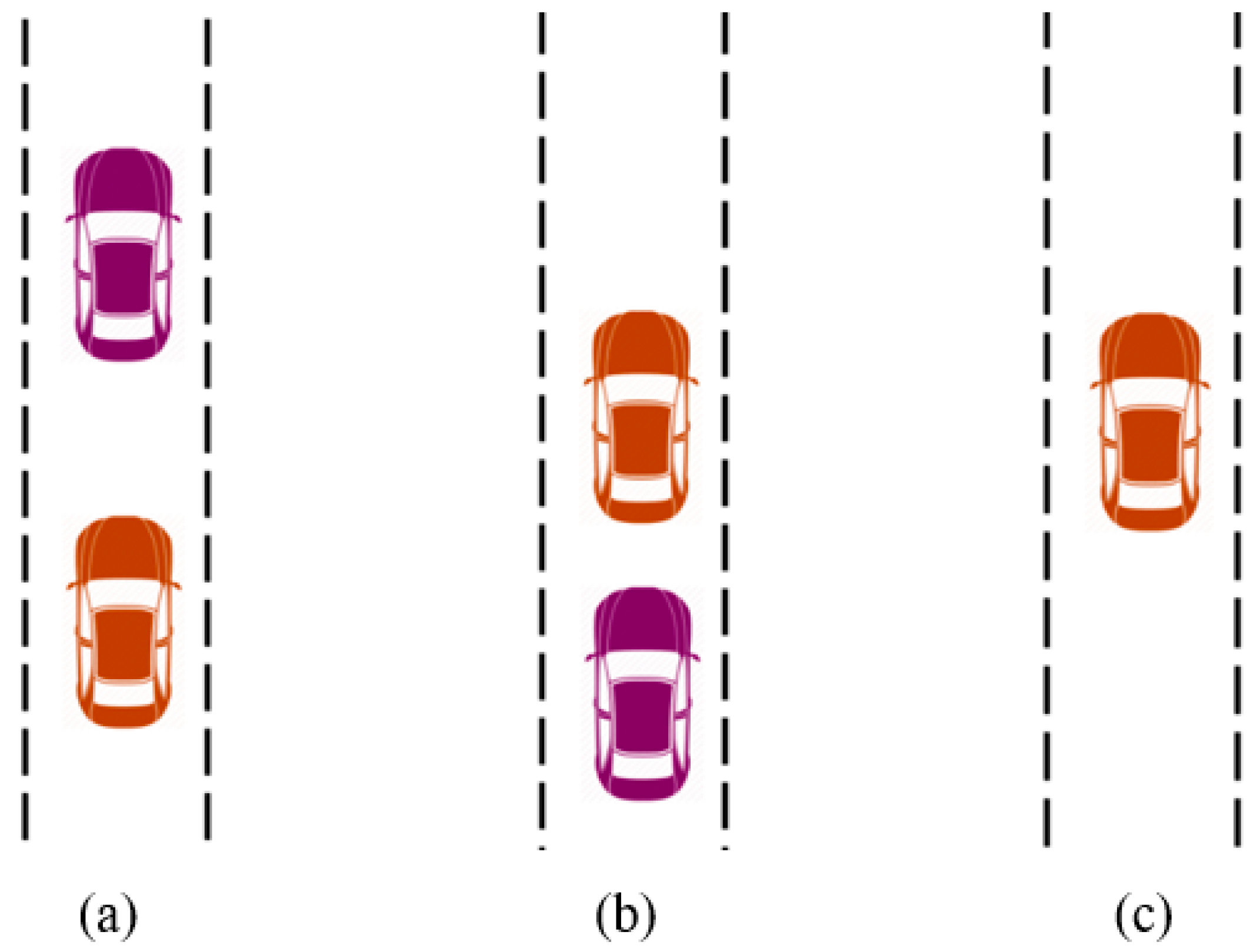
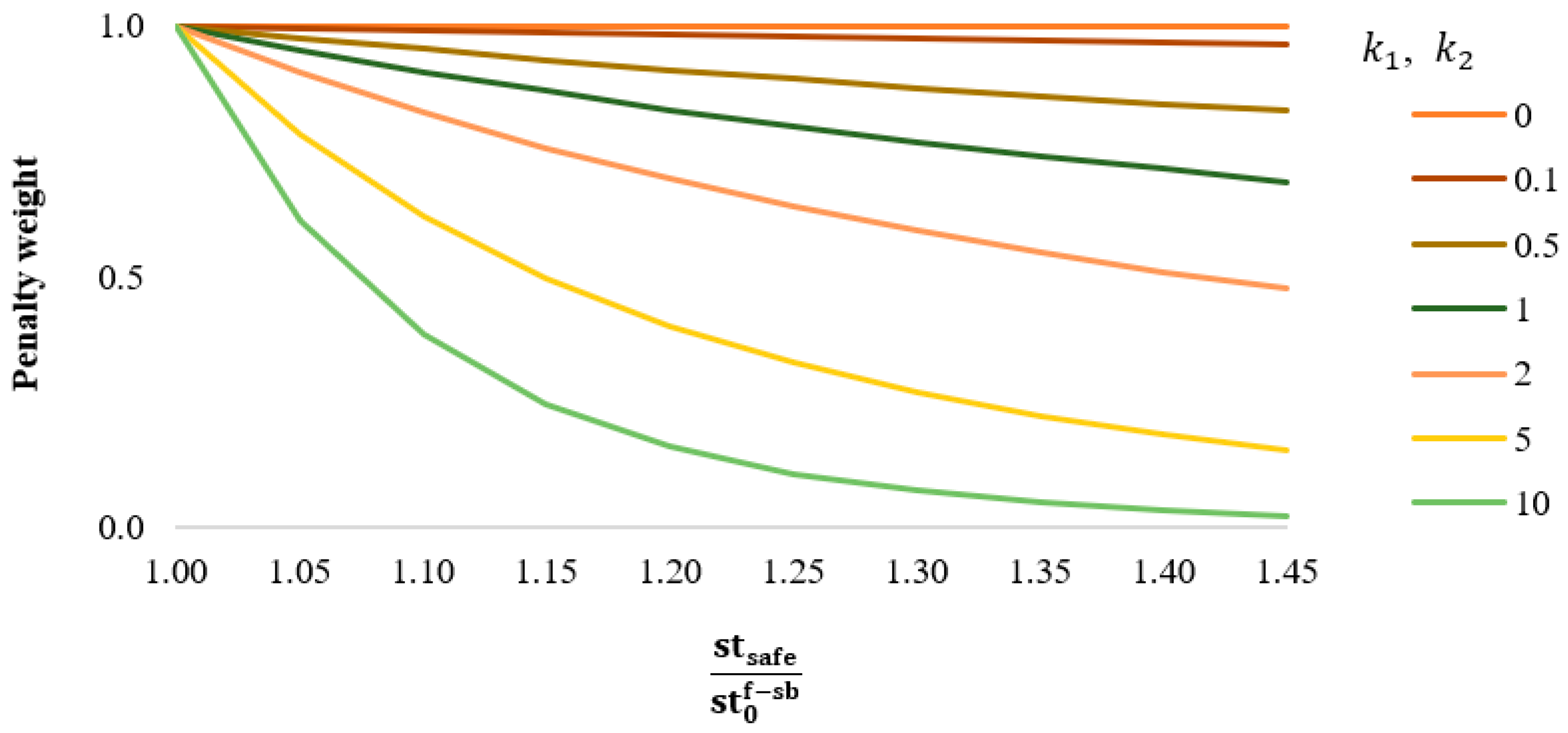
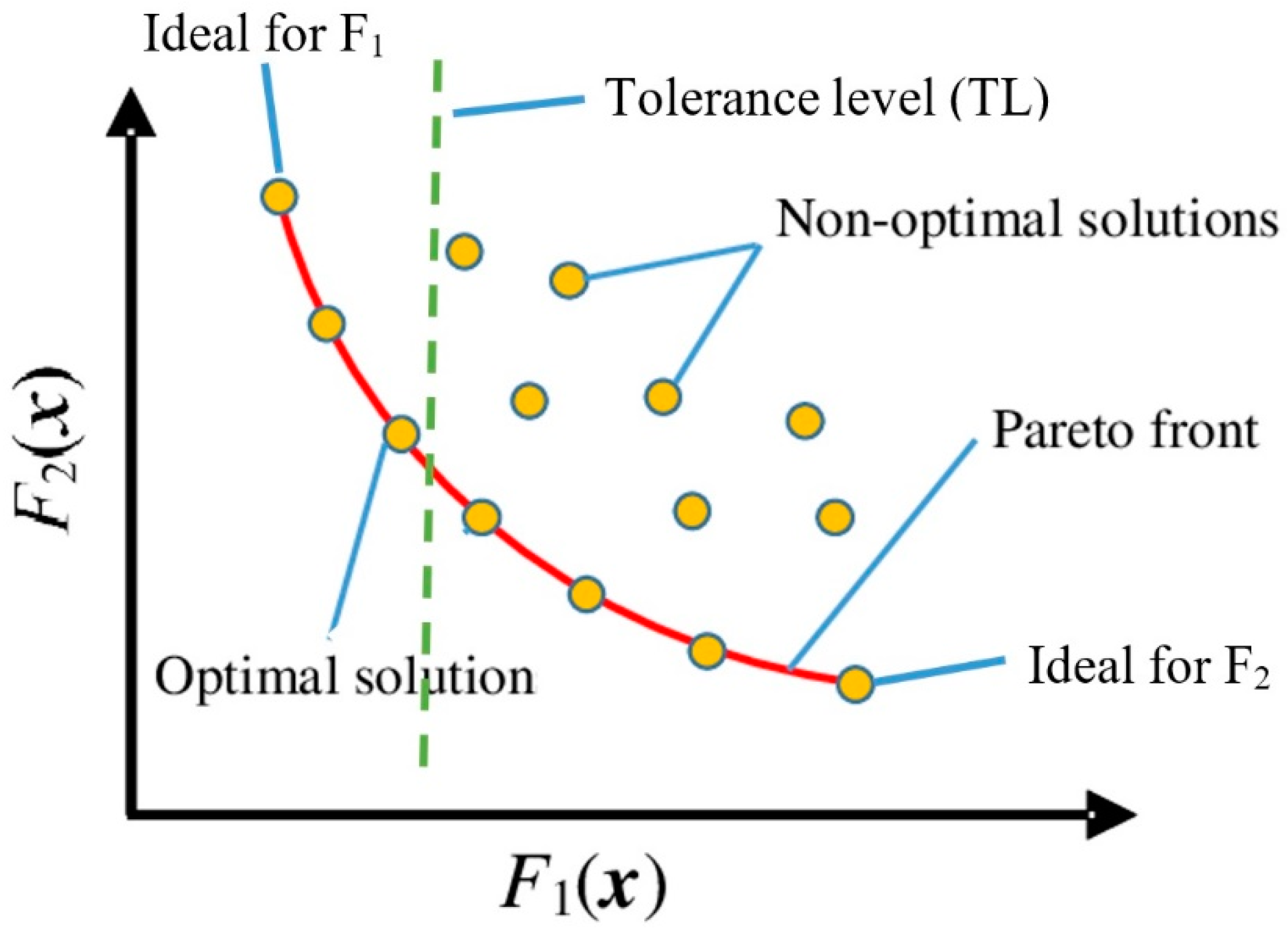


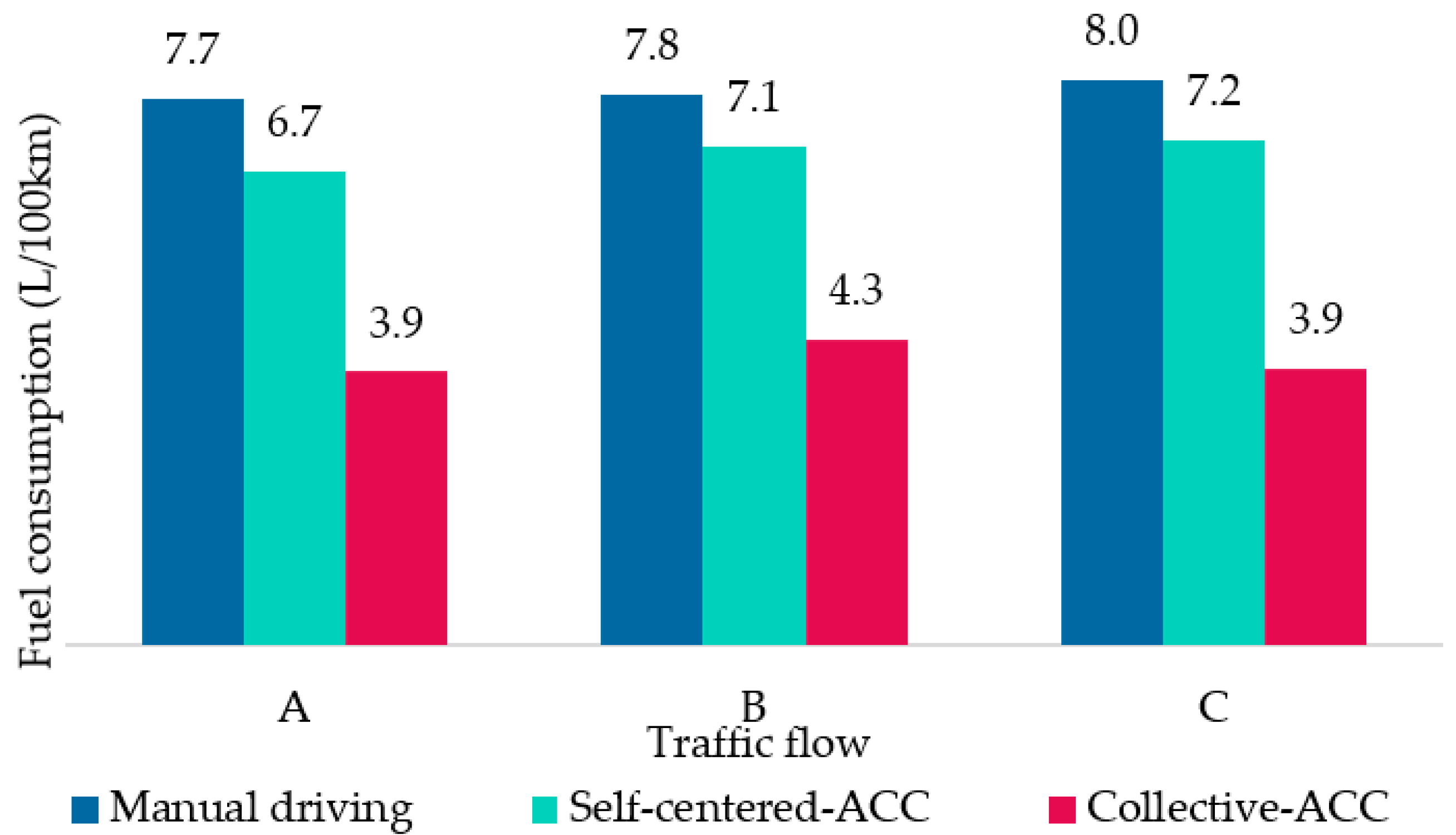
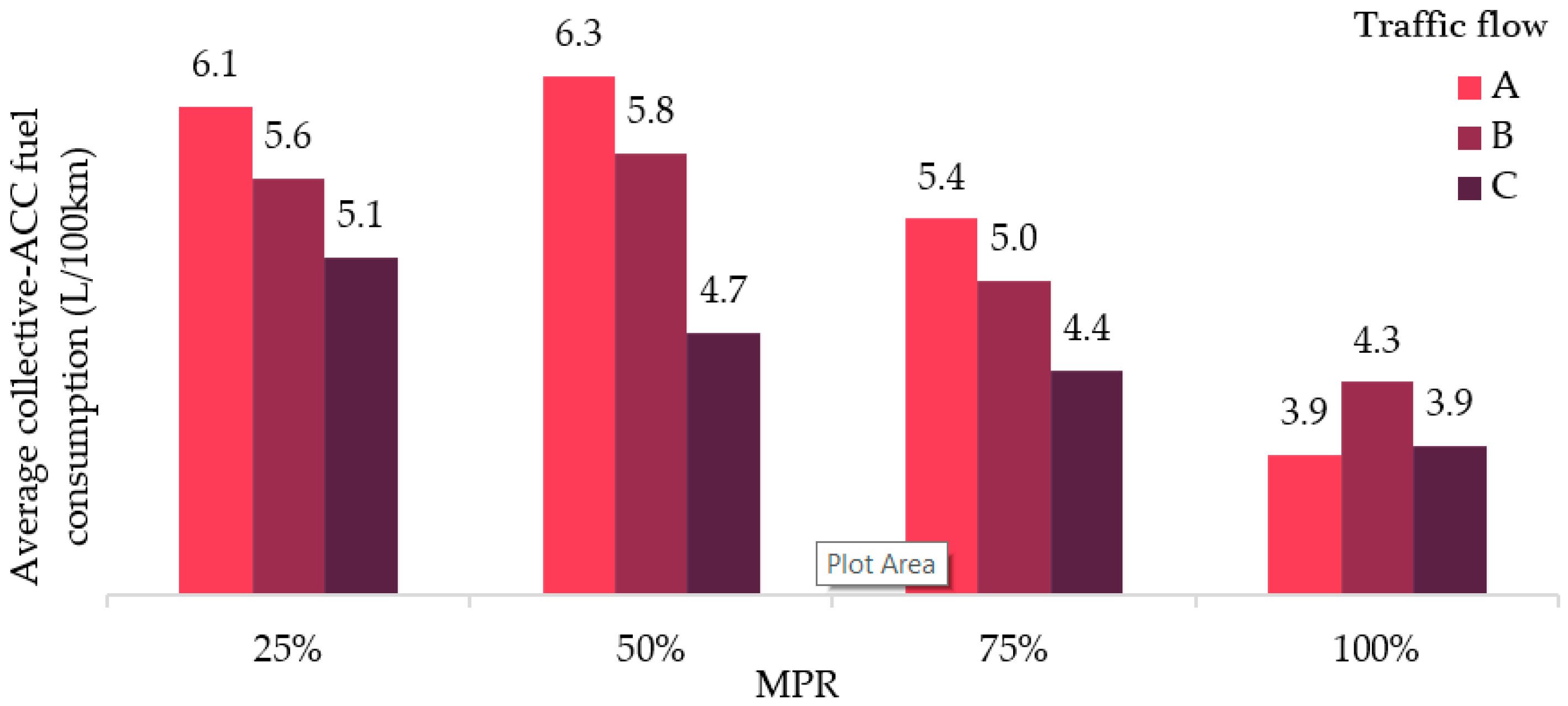
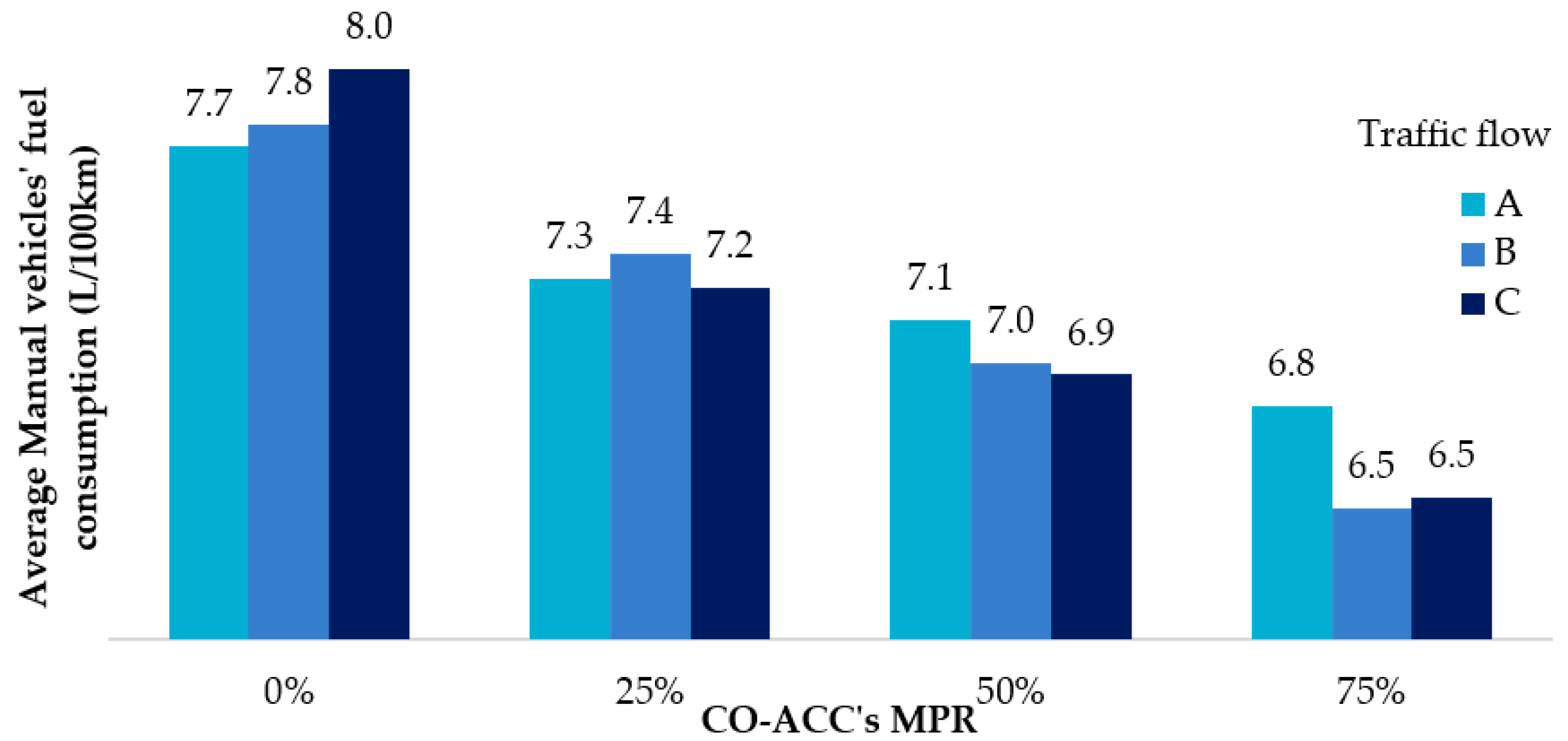

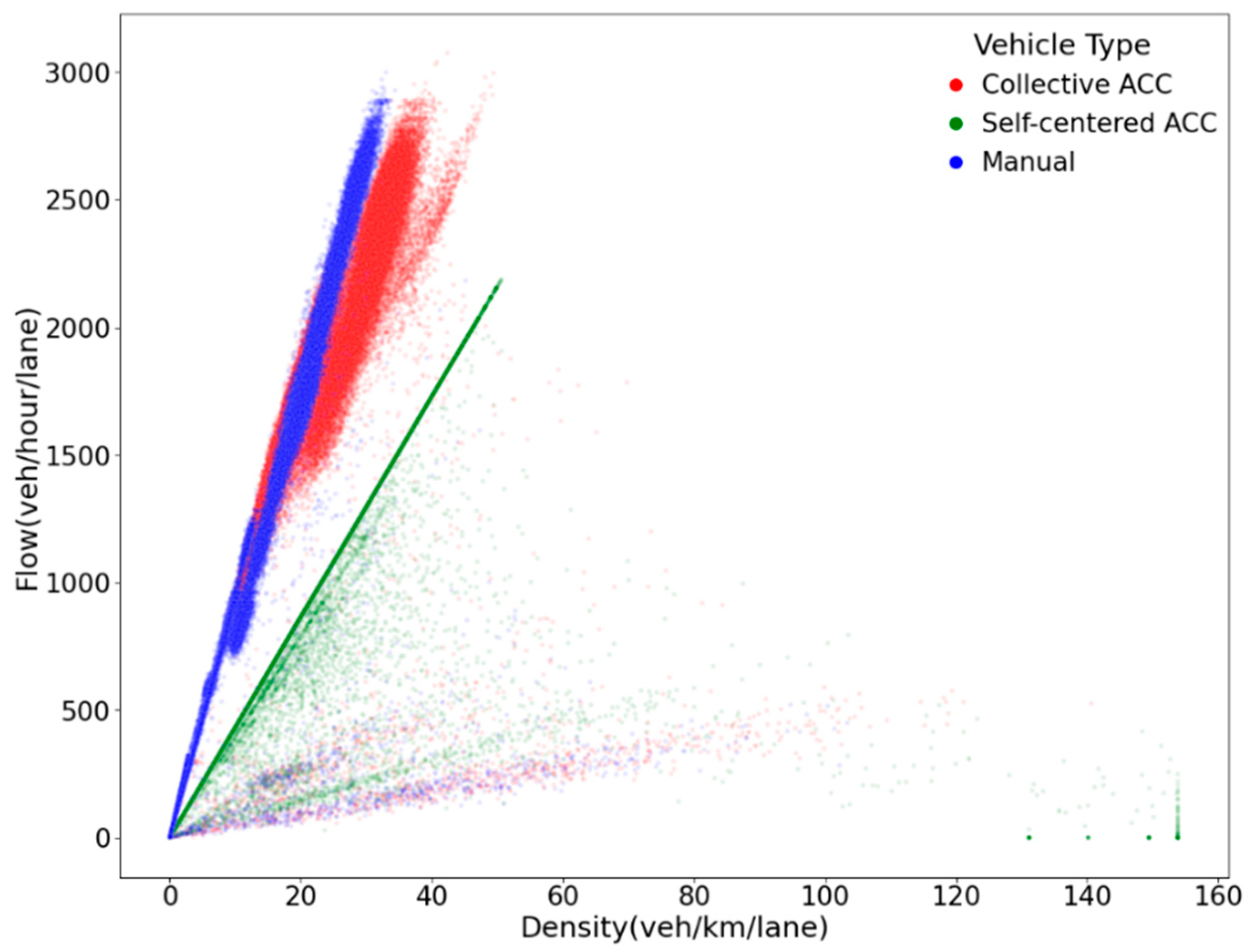
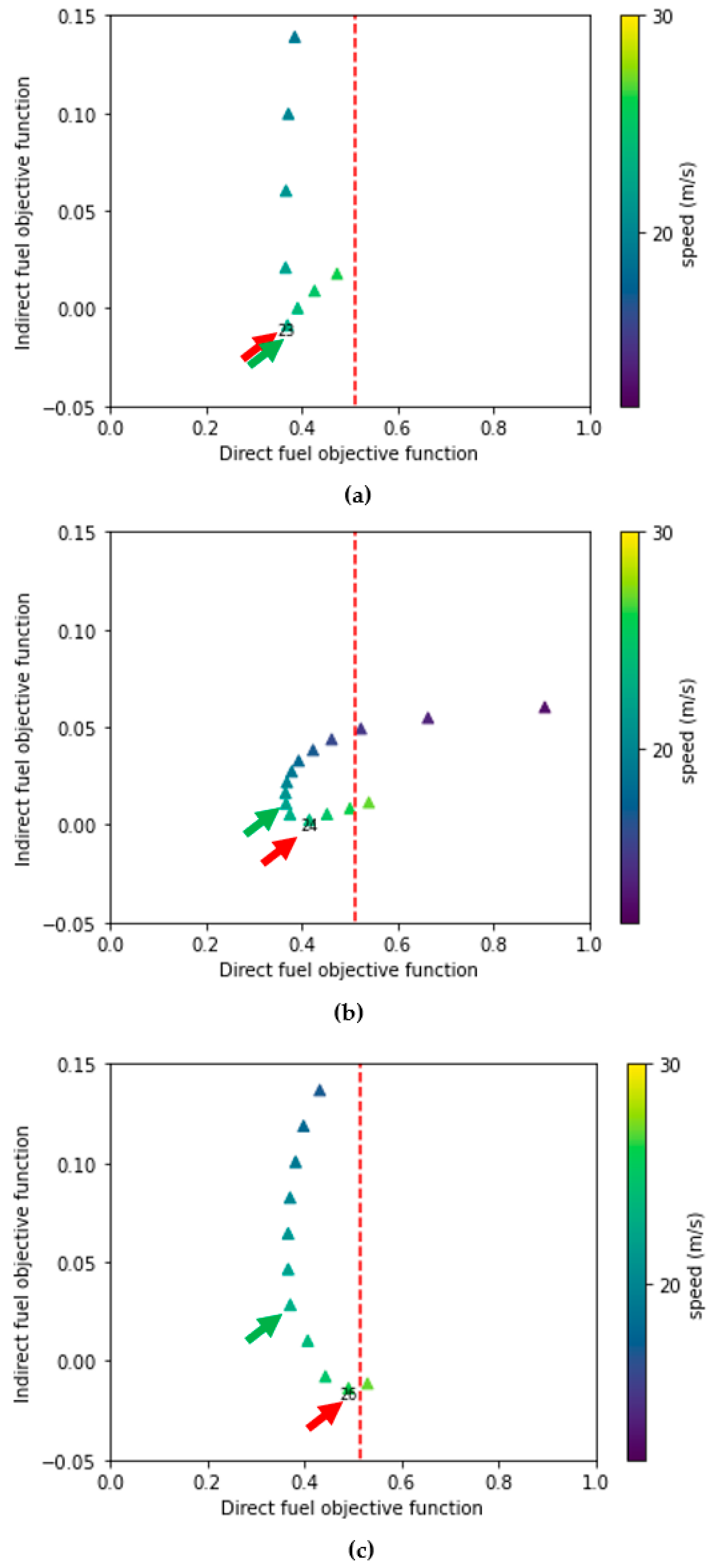
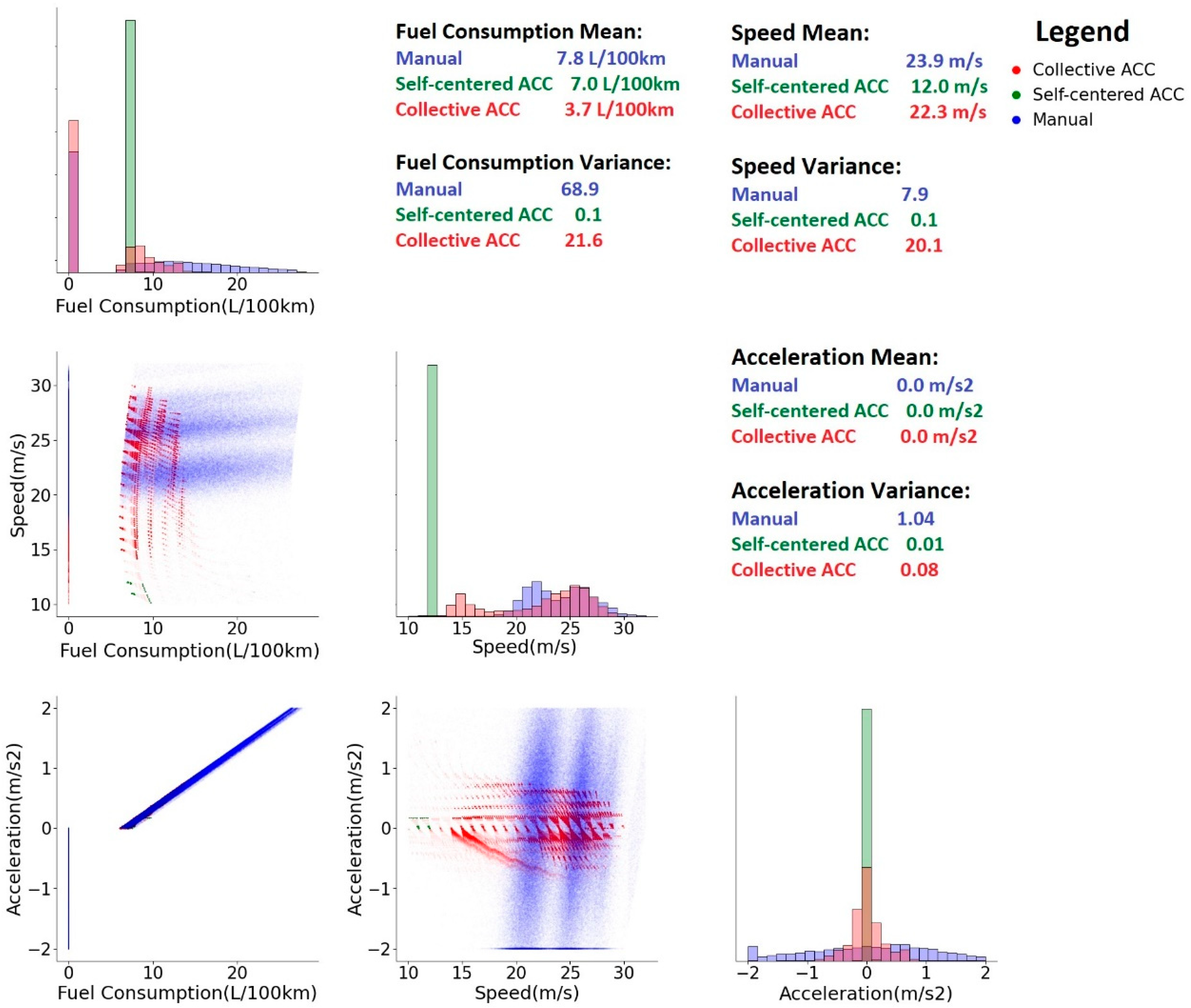

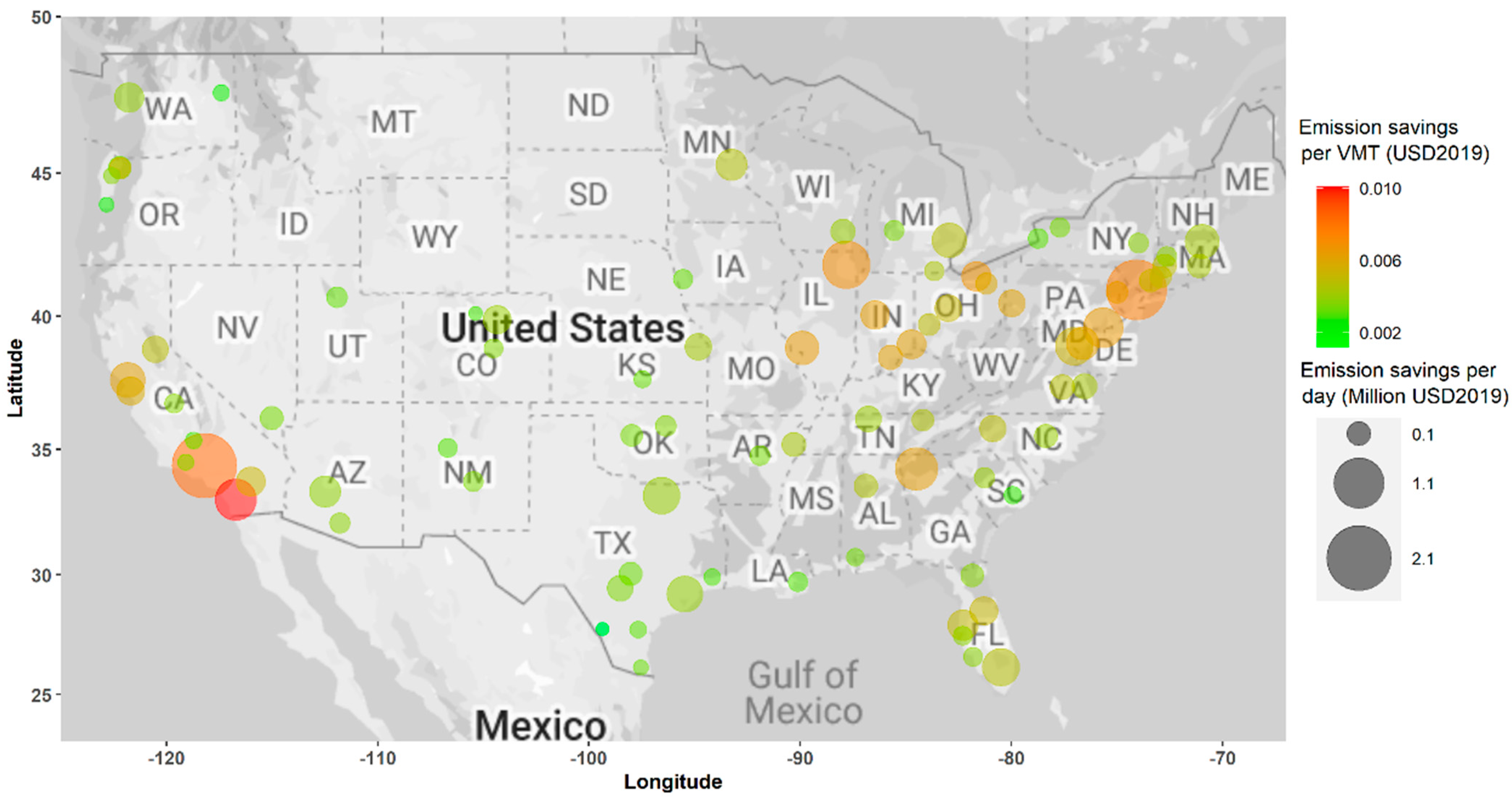

| Trends | Challenges |
|---|---|
|
|
| Parameter | Values | ||||||
|---|---|---|---|---|---|---|---|
| k1 and k2 | Parameter values | 0.5, 0.5 | 1, 1 | 2, 2 | 5, 5 | 0.5, 1 | 1, 0.5 |
| Fuel consumption (L/100 km) | 6.9 | 6.4 | 7.2 | 6.7 | 6.9 | 7.1 | |
| stsafe | Parameter values | 1 s | 0.5 s | 0.3 s | 0.1 s | ||
| Fuel consumption (L/100 km) | 6.4 | 6.1 | 5.1 | 5.5 | |||
| TL | Parameter values | 10% | 30% | 40% | 60% | 80% | |
| Fuel consumption (L/100 km) | 5.1 | 4.4 | 4.3 | 5.0 | 4.5 | ||
| w1 and w2 | Parameter values | 0.1, 0.9 | 0.3, 0.7 | 0.5, 0.5 | 0.7, 0.3 | 0.9, 0.1 | |
| Fuel consumption (L/100 km) | 6.8 | 6.9 | 5.1 | 4.3 | 4.5 | ||
| T | Parameter values | 3 s | 5 s | 10 s | |||
| Fuel consumption (L/100 km) | 4.9 | 4.3 | 5.8 | ||||
| Traffic Flow Level A | Traffic Flow Level B | Traffic Flow Level C | |||||||||||||||
|---|---|---|---|---|---|---|---|---|---|---|---|---|---|---|---|---|---|
| Automaker #1 | Automaker #1 | Automaker #1 | |||||||||||||||
| S-ACC | CO-ACC | S-ACC | CO-ACC | S-ACC | CO-ACC | ||||||||||||
| Automaker #2 | S-ACC | 1.0 | 2.6 | Automaker #2 | S-ACC | 0.7 | 1.2 | Automaker #2 | S-ACC | 0.8 | 1.1 | ||||||
| 1.0 | 0.1 | 0.7 | 0.1 | 0.8 | 0.1 | ||||||||||||
| CO-ACC | 0.1 | 3.9 | CO-ACC | 0.1 | 3.5 | CO-ACC | 0.1 | 4.1 | |||||||||
| 2.6 | 3.9 | 1.2 | 3.5 | 1.1 | 4.1 | ||||||||||||
| Parameter | Estimation Method |
|---|---|
| Accident-related congestion reduction | Negligible |
| Non-accident-related congestion reduction | Negligible |
| Aerodynamic force reduction | Regression models on the traffic simulation data |
| Operation load | Two radars and a speed control unit active in non-congested freeway travel |
| Traffic rebound | Fuel economy traffic rebound model |
Publisher’s Note: MDPI stays neutral with regard to jurisdictional claims in published maps and institutional affiliations. |
© 2021 by the authors. Licensee MDPI, Basel, Switzerland. This article is an open access article distributed under the terms and conditions of the Creative Commons Attribution (CC BY) license (https://creativecommons.org/licenses/by/4.0/).
Share and Cite
Vasebi, S.; Hayeri, Y.M. Collective Driving to Mitigate Climate Change: Collective-Adaptive Cruise Control. Sustainability 2021, 13, 8943. https://doi.org/10.3390/su13168943
Vasebi S, Hayeri YM. Collective Driving to Mitigate Climate Change: Collective-Adaptive Cruise Control. Sustainability. 2021; 13(16):8943. https://doi.org/10.3390/su13168943
Chicago/Turabian StyleVasebi, Saeed, and Yeganeh M. Hayeri. 2021. "Collective Driving to Mitigate Climate Change: Collective-Adaptive Cruise Control" Sustainability 13, no. 16: 8943. https://doi.org/10.3390/su13168943
APA StyleVasebi, S., & Hayeri, Y. M. (2021). Collective Driving to Mitigate Climate Change: Collective-Adaptive Cruise Control. Sustainability, 13(16), 8943. https://doi.org/10.3390/su13168943





